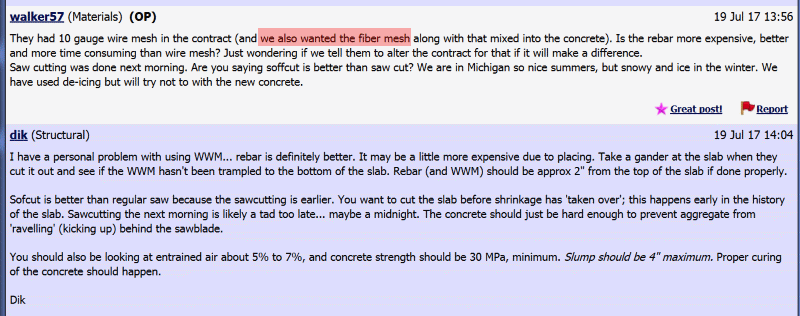We had a driveway and walkway poured recently and it started to pour rain. Puddles were forming on the half of the driveway that didn't have anything on it yet but they kept pouring and the concrete was looking quite sloppy. The rain got a bit lighter, but still kept falling on the concrete while they were trying to smooth it with the boards. We are concerned that the driveway is going to have problems because for several minutes during the pour, the rain got very heavy. I included a picture where you can see the drops. The walkway was being poured while there was a heavy downpour. How worried should I be with all the rain being mixed in with the concrete?
Not only that, but our order/contract specified that fiber mesh be mixed in with the concrete, but we found out the next day that they forgot to add it in! We did have wire mesh laid on the driveway...and it was also supposed to be on the walkway, but they forgot to put the wire mesh down there!
Any suggestions on whether we should pay this company? The sales guy is also the son of the owner and he was supposed to oversee the project but was out of town. He knew there was a good chance of isolated showers but ordered the guys to pour it. He didn't even realize the fiber mesh wasn't in the concrete until we examined it and texted him and he admitted it was not there.
When they pulled the boards off the walkway the following day, the edges were jagged and chipped and pieces broke off on the sides...which they just patched up.
Clean up was terrible with muddy cement from the run-off powerwashed down into the street in front of our driveway and also down the neighbors front curb and left there. And...muddy cement splattered from the powerwasher all over 2 of our newly leased vehicles in the street. The cement splatter was baked on by the sun all afternoon before we saw it so we now have to get it specially cleaned and detailed so we don't scratch the finish.
It has not been a very good experience.
Considering the driveway was poured when there was heavy rain, forgetting to have the fiber mesh included in the concrete and also forgetting to put the wire mesh in the walkway, completely splattering our vehicles with muddy cement (which baked on from the hot sun)....any suggestion on what would be a fair way to handle this?
We do not want them back at the house to do any more work because there is now a trust issue and we don't want any more bad experiences.
By the way...yes, I did research them and they have been in business for quite a while and this is also a company that has good reviews on Angies List and no complaints yet on BBB.
Not only that, but our order/contract specified that fiber mesh be mixed in with the concrete, but we found out the next day that they forgot to add it in! We did have wire mesh laid on the driveway...and it was also supposed to be on the walkway, but they forgot to put the wire mesh down there!
Any suggestions on whether we should pay this company? The sales guy is also the son of the owner and he was supposed to oversee the project but was out of town. He knew there was a good chance of isolated showers but ordered the guys to pour it. He didn't even realize the fiber mesh wasn't in the concrete until we examined it and texted him and he admitted it was not there.
When they pulled the boards off the walkway the following day, the edges were jagged and chipped and pieces broke off on the sides...which they just patched up.
Clean up was terrible with muddy cement from the run-off powerwashed down into the street in front of our driveway and also down the neighbors front curb and left there. And...muddy cement splattered from the powerwasher all over 2 of our newly leased vehicles in the street. The cement splatter was baked on by the sun all afternoon before we saw it so we now have to get it specially cleaned and detailed so we don't scratch the finish.
It has not been a very good experience.
Considering the driveway was poured when there was heavy rain, forgetting to have the fiber mesh included in the concrete and also forgetting to put the wire mesh in the walkway, completely splattering our vehicles with muddy cement (which baked on from the hot sun)....any suggestion on what would be a fair way to handle this?
We do not want them back at the house to do any more work because there is now a trust issue and we don't want any more bad experiences.
By the way...yes, I did research them and they have been in business for quite a while and this is also a company that has good reviews on Angies List and no complaints yet on BBB.

![[idea] [idea] [idea]](/data/assets/smilies/idea.gif)
![[r2d2] [r2d2] [r2d2]](/data/assets/smilies/r2d2.gif)
